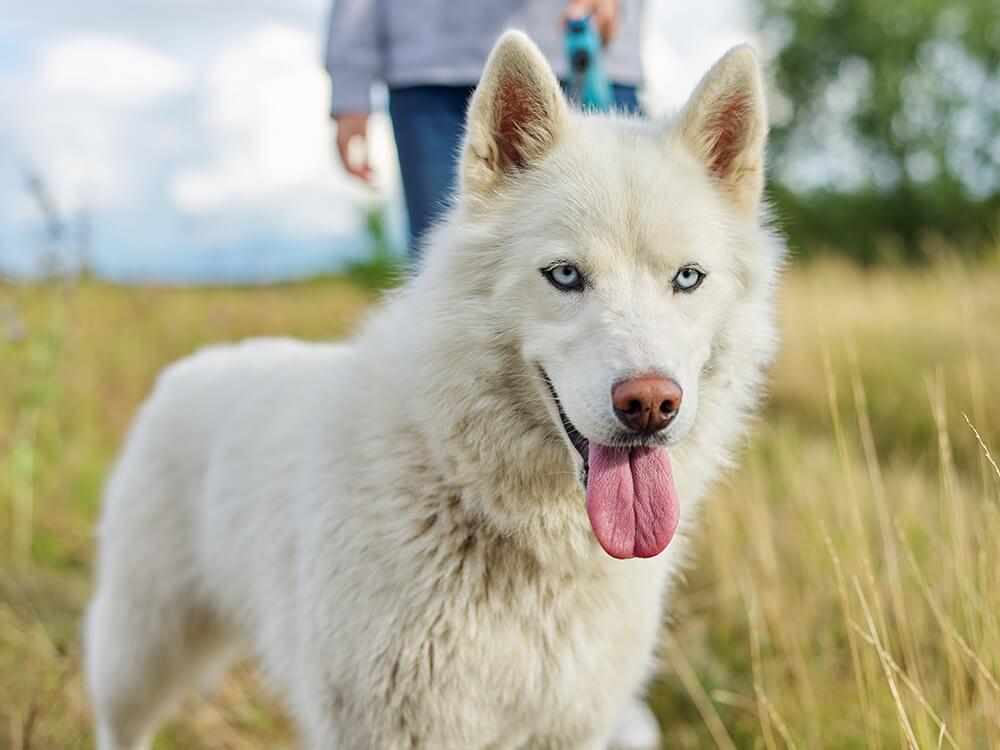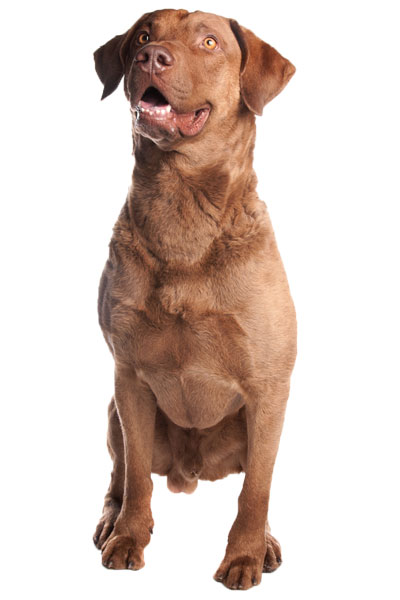Not the breed you're looking for?
Click Here
Featured Story

Because of his pristine coat, the White Husky can be easily mistaken for an Albino Dog or Isabella Husky. We will help you differentiate him from … [Read More...]
The Chesapeake Bay retriever originated in the USA. Interestingly, its ancestors are believed to have been the rescued puppies from an 1807 shipwreck in Chesapeake Bay, Maryland. Standing 56–66 centimetres at the withers and weighing 65–80 pounds, the Chessie has a classic retriever look, yet it has a broad head with a medium stop and thin lips that do not hang. This breed is registered with the Kennel Club and other major breed registries.
Are you thinking of getting a Chesapeake Bay retriever? Here is a brief background of this loyal, courageous, and happy large dog.
In 1807, two puppies similar to Newfoundland dogs were rescued from a shipwreck in Chesapeake Bay, Maryland. These water-loving puppies, which grew to be great duck hunters, were bred with local retrieving dogs. The resulting puppies are believed to be the ancestors of the Chesapeake Bay retriever. Other breeds used to develop the breed were the curly-coated and the flat-coated retrievers, coonhound, and Irish water spaniel. The Chesapeake Bay retriever’s strength, stamina, sturdy build, and dense coat allowed it to successfully work in rough, icy waters.
Breed standards were established in 1885 and the Chessie only arrived in the UK in 1933. It is recognised by major registries, including the Kennel Club here in the UK under the Gundog Group. Since the 1970s, the breed has been a popular gun dog as well as a companion and family pet.
The Chesapeake Bay retriever has a classic retriever look, sporting a muscular body with a short, slightly wavy hair and hanging ears. A major difference is its broad head with a medium stop, thin lips that do not hang, well-developed nostrils, and webbed feet used for swimming. The Chessie has medium eyes that are set wide apart, a strong jaw with a perfect scissor bite, and a moderately long neck. The colour of its nose and lips depend on its coat. The male is easily distinguishable from the female. The average height is 56–66 centimetres and weight is 65–80 pounds.
The Chessie is a large dog that boasts of a unique coat comprising of a harsh, oily outercoat and a fine, dense, woolly, and weather-resistant undercoat covering its entire body. This combination provides the right insulation that enables the breed to hunt in all conditions even in ice and snow. The hair in its neck, shoulders, back, and loins is wavy. A little feathering on its tails is permitted.
Accepted colours according to KC standards are ash, brown, light brown, dark brown, dead grass, and sedge. These colours allow the Chessie to camouflage in its surroundings, which is specifically helpful in hunting. Although this breed sheds heavily in the spring and autumn, grooming is relatively easy because it does not need to be taken to a professional groomer for trimming or clipping. Regular brushing will take care of the dead hair and distribute natural oils. A warm bath will also be beneficial during shedding season.
Apart from caring for its coat, also pay attention to its teeth, ears, and nails. Some owners tend to ignore other aspects of grooming and only focus on the coat. Also check your Chessie’s skin for abnormal spots and fleas/ticks.
The Chesapeake Bay retriever, like other retrievers, is a happy, affectionate, and loyal companion. It has a natural compassion toward children, but won’t put up with too much pestering and would rather walk away. It not recommended for families with very young children as it tends to be protective of its food and toys. It may also wrongly judge boisterous play as danger. However, as a breed that matures late and develops protective tendencies at around three years old, early training and socialisation will help control unwanted behaviours. The Chessie usually get along with other family pets but can be aggressive toward animals they do not know.
As a working dog, the Chessie is courageous, alert and hardworking, which characteristics also make it a good watchdog. As an outdoor breed, it is not suited for city apartment living with families living sedentary lives. It thrives in the countryside where it could roam around and explore. Don’t let its retriever lineage fool you. It is not as even-tempered as its Labrador and Golden cousins. It can be stubborn and may test your alpha role. It is best suited for experienced owners that are firm and consistent.
A typical serving for an adult Chesapeake Bay retriever is 2–2.5 cups of excellent-quality dry dog food per day. Ask your trusted veterinarian regarding the frequency and amount of food as they can offer helpful advice.
Typical calorie needs of an adult Chesapeake Bay retriever per day:
As an active working dog, the Chesapeake Bay retriever needs more protein and less carbohydrates in its diet. This is to support its high energy requirements. A good guide will be having a diet composed 80 per cent meat and 20 per cent vegetables. Experts suggest a grain-free diet to avoid skin allergies and stomach problems. As for supplements, glucosamine and chondroitin sulphate are important for the joints. Also ask the vet regarding supplements that would decrease inflammation and repair/strengthen tissues of your active dog.
A properly-cared-for Chesapeake Bay retriever can live up to thirteen years. It is a generally healthy breed, but like other dogs, it could have hereditary health issues. For instance, it is prone to eye problems like cataracts, progressive retinal atrophy, entropion, as well as joint and bone issues like hip and elbow dysplasia and degenerative myelopathy. It can also develop umbilical hernia, von Willebrand disease, bloat, and ear infections.
The Chessie has extremely high exercise requirements. It needs at least two hours’ worth of physically and mentally stimulating activities or it will display destructive behaviour. Aside from allowing it to freely roam around a fenced yard, let it engage in sporting activities such as agility and obedience training. Being in the water will also make this breed truly happy.
Chesapeake Bay Retrievers are a rare breed in the UK and acquiring one means going on a waiting list first. Be ready to pay at least £800 for a pedigree puppy especially if you are going to purchase from reputable breeders. You would also need to consider the price of high-quality dog food, whether wet or dry, as well as treats, which can be anything from £40-£60 per month.
To make your dog comfortable in your home, you need to buy basic equipment and supplies, which will set you back around £200. Routine veterinary consultations to keep your dog healthy will cost as much as £1,000 annually. This does not include additional expenses if it gets ill or if it needs surgeries or long-term treatments. This is why getting a pet insurance is recommended. Monthly costs start at £20 for basic and £50 for lifetime, depending on the premium you choose. Make sure to check the different insurance policies and their coverage before purchasing the most suitable one for your dog.

Are you sure the Chesapeake Bay Retriever is the best breed for you? Take the Pet Breed Selector Quiz to find your perfect breed match.
Dog Breed Selector QuizStill having doubts if the Chesapeake Bay retriever is the best breed for you? Try taking our Pet Finder to help you find dog breeds that will complement your lifestyle.